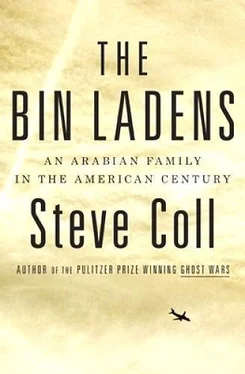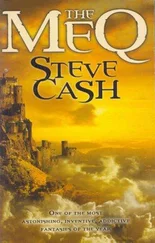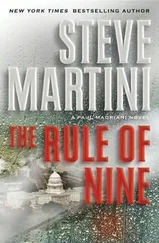Suleiman owned a transport business that profited from the pilgrim trade to Mecca. He owned land across the kingdom and after the war he began to develop hotels. He planned one for Dammam, near the American-run oil fields, which he hoped to endow with a bar and movie theater, plans that proved too ambitious, since Islamic scholars in the kingdom had decreed movies illegal—along, of course, with alcohol. He entered into partnerships with many Saudi merchants; his partner in one Jeddah firm, named Ibrahim Shakir, who imported Dodge cars and trucks, became “one of the wealthiest private citizens in Saudi Arabia, beneficiary of many fat government contracts,” according to an American cable. Suleiman acquired farms and irrigated them with scarce water supplies, and he protected his land from encroachments—when the Saudi government sought to improve Jeddah’s sanitation by piping fresh water from one of Suleiman’s estates, he shut the project down. Alcohol exacerbated the effects of age and an itinerant life without modern medical care. Suleiman fell out of sight for months at a time; he typically said he was fishing in the Red Sea. The American embassy feared that the minister was losing his grip and “hitting [the] bottle” at an “increasing rate.” 4
King Abdulaziz never cared about money as much as his sons and advisers did, but when he occasionally ran out, he became annoyed. In December 1949 the king demanded 10 million riyals from Suleiman to provide wedding gifts to some of his sons and daughters who were soon to be married. When Suleiman told him that the treasury was empty, Abdulaziz was apoplectic. In a supposed move toward reform, the minister of finance summoned from Cairo Najib Salha, his wartime profiteering crony. Having been taken once, the British government was “not particularly hopeful…that the Augean stables of the Saudi Arabian Ministry of Finance will be any cleaner for his arrival.” 5
Nor were the Americans. They increasingly regarded the self-dealing and commissions that Suleiman oversaw as an obstacle to Washington’s plan to secure its alliance with Saudi Arabia by promoting rapid economic and social progress in the kingdom. The king’s budget allocated five times more for palaces and support of the royal family and its allies than it did for the embryonic Ministry of Health. 6Royal excess and social inequality might make the Saudi population vulnerable to the utopian appeals of the international communist movement, some American officials feared.
As oil flowed during the late 1940s, the Bechtel Corporation negotiated a cost-plus contract with the Saudi government to undertake an ambitious plan, influenced by Washington, to help lift the kingdom into the modern capitalist age. Bechtel’s imported bulldozers demolished Jeddah’s old city walls and plowed the sand to build piers, ports, airports, and an asphalted road that could speed visiting pilgrims from Jeddah to Mecca. Saudi princes, however, criticized Bechtel’s profits as excessive and impossible to police. For its part, Bechtel discovered that Suleiman, the king, and his sons expected the company to be on call around the clock to repair broken refrigerators, air conditioners, or even automobiles at their private palaces. The royal family ordered Bechtel’s bulldozers and earthmovers diverted from roads and airports to such work as the digging of a sunken garden at the palace of Prince Faisal, the king’s second son. Moreover, Suleiman fell behind on the government’s payments to Bechtel; by the summer of 1950, the Saudis owed the company $2 million. Stephen Bechtel told the State Department that “the headaches” of his company’s Saudi work “far outweighed the advantages.” 7
Abdulaziz’s sons and advisers were divided by factional feuds that proved impossible for Bechtel’s executives to manage. When the electricity went out at the huge Riyadh palace of the king’s eldest son, Saud, the prince became furious at Bechtel. At the same time, Saud complained that his brother Faisal was spending royal funds too freely, a rich gripe coming from him. Suleiman threw up his hands and said the boys were beyond his ability to control. Abdulaziz was by this time largely oblivious. His legendary energy had drained away with age, and he napped through his days, encased by his many wives, bodyguards, and slaves. He suffered from cataracts in both eyes, one of which drooped in near blindness. Simply moving the king from one palace to another had become an epic production: when Abdulaziz shifted himself and his entourage from Riyadh to Taif in the summer of 1951, it required fifty-five flights over three days and the diversion of every aircraft in the young fleet of Saudi Arabian Airlines. 8
Bechtel’s failure to adapt to the royal family’s way of business created openings for Mohamed Bin Laden. The Americans obsessed about the timeliness of hard currency payments to their New York bank accounts; Bin Laden relied upon a much more flexible network of Hadhrami moneylenders based in Jeddah. The Americans wrung their hands over the excesses of Suleiman and the Saudi princes; Bin Laden saw Abdulaziz and his heirs as faithful Muslims ordained by God to rule over Mecca and its environs, and he skillfully cast himself as their obedient and enterprising servant.
Around this time Bin Laden began to prove himself, too, to the committees of Islamic scholars appointed by Abdulaziz to oversee public works in Mecca and Medina. The scholars awarded him contracts to build mosques in the Hejaz, and as the postwar boom gathered momentum, the scale of Bin Laden’s contracts for religious works increased. In earlier periods, Egyptian and Lebanese firms had won much of the repair and renovation work in the Islamic holy cities; these companies had connections with the previous Ottoman regime and they employed European-trained engineers. But Abdulaziz found it useful to have a favored contractor of his own. Like Mecca’s guardians before him, the king took great pride in sponsoring improvements that would impress pilgrims visiting from around the world. At his instruction, Mohamed Bin Laden traveled to Beirut in 1949 to purchase tents that could shield worshippers from the sun as they prayed at Mecca’s grand mosque. When the Lebanese businessman who made the tents, Ahmed Fathalla, flew to Mecca to install them, King Abdulaziz happened to arrive to wash the Ka’ba, the holy black cube that is the focal point of Muslim prayer. Among the king’s entourage was Mohamed Bin Laden, Fathalla recalled; Bin Laden and Abdulaziz were “always together, side by side.” The next year, Bin Laden was appointed to build a series of dams and reservoirs, at an estimated cost of $1 million, which could pipe fresh water to Mecca from a newly discovered well twenty-eight miles away. A Belgian company provided Bin Laden with an experienced engineer, as well as high-grade piping from Germany. The mason from Wadi Doan was building an international network of Arab and European business contacts and partners. 9
The king ratified Bin Laden’s rise by issuing a Royal Order on May 24, 1950, which appointed Mohamed “Director-General of Construction Works of King Abdulaziz”; he was assigned to work under Suleiman and now had a title to wave around when he needed one. To the consternation of Bechtel executives, Bin Laden moved the company’s heavy equipment from the Jeddah-Mecca road so he could use it “for grading around the new residence” he was building for Suleiman by the Red Sea. (Bechtel and State Department correspondence recording this diversion of construction equipment, dated January 17, 1951, apparently marks the first time that the Bin Laden family name appeared in an American government document.) 10
The boom in palace construction in which Bin Laden specialized had now become influenced by Western notions of luxury, as an American cable from that winter reported:
Читать дальше












